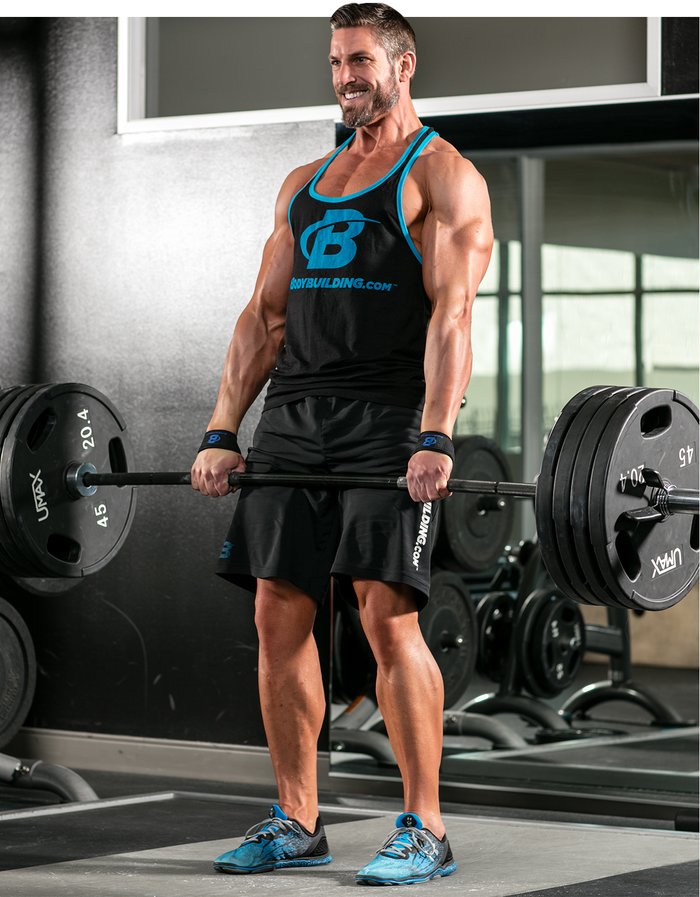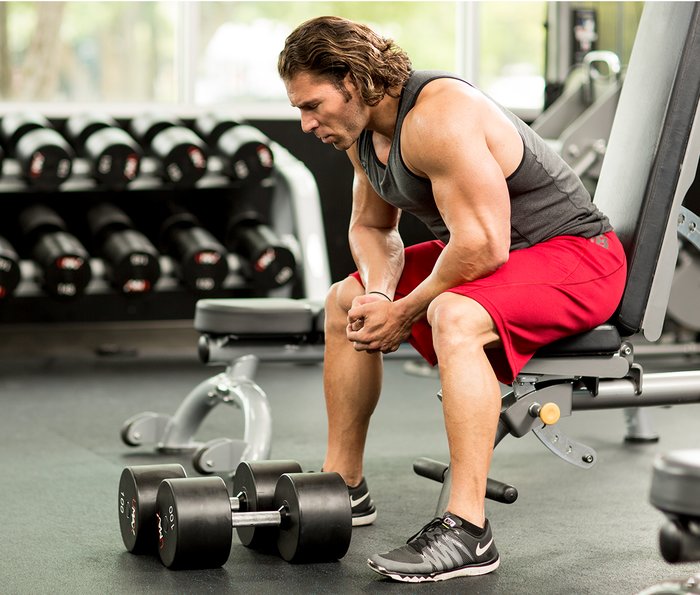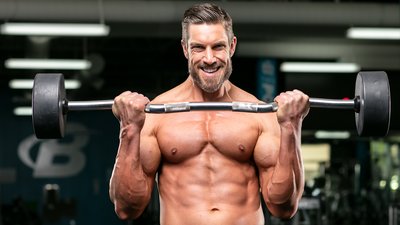Anyone can walk into a gym, lift a bunch of weights for a bunch of reps without any real plan or pattern, and probably get some degree of muscle growth for their efforts. But the chances are that their success won't last forever, and along the way, they'll end up wasting a lot of time and energy.
If you're looking to fast-track your gains in size rather than spend more time than is necessary, the research plainly shows there are certain ways to train that are more effective than others.
More specifically, some exercises are better than others, some loads are more optimal for building maximal size, and certain training styles and training volumes can put you on the road to muscle growth.
To be clear, every apparent "rule" in here can be broken successfully. But before you do that, make sure you've put in your time to build your foundation. Here's how to manipulate your training variables properly to design the most effective muscle-growth program!
1. Intensity: Moderate
Training intensity is arguably the most important exercise variable for stimulating muscle growth.[1] Commonly expressed as a percentage of your single-rep max or 1RM, intensity equates to the number of repetitions you can perform with a given weight. The heavier the weight, the fewer reps you can do.
Moderate rep ranges of 6-12 per set have been shown to optimize the hypertrophic response, with loads less than 65 percent of 1RM not considered sufficient to optimize muscle growth.[2] Studies of bodybuilding-style exercise routines performed with multiple sets of 6-12 have demonstrated post-exercise increases in metabolites, like lactate and hydrogen ions, which have a significant impact on anabolic processes.[3]

"Muscle damage is also tied into muscle soreness," says researcher and author Rob Wildman, PhD, RD, FISSN, who is on the faculty in the Department of Human Nutrition at Kansas State University. "And while some damage can help maximize gains, the goal shouldn’t be to cause excessive damage of the muscle. This can lead to slower recovery and disrupt training quality and volume over time."
Both testosterone and growth hormone are elevated to a greater degree in training programs that employ sets of 6-12 rep as compared to high-intensity sets using lower rep ranges.[4,5] Moreover, the increased time under tension associated with moderate rep ranges is ideal for causing fatigue across the full spectrum of muscle fibers, maximizing increases in muscle size.[1]
Is there a time and a place for lower-rep strength-focused training? Of course. But if muscle size is your goal, moderate reps most of the time will get you there more predictably.
2. Volume: High
Higher-volume, multiple-set protocols have consistently been shown to be superior over single sets when it comes to muscle hypertrophy.[6,7] High-volume programs that generate a significant amount of glycolytic activity (think bodybuilding-style programs) elevate testosterone and growth-hormone levels to a greater extent than low-volume routines do.[5,8]
For this reason, a split routine, where you perform multiple exercises for a specific muscle group, may be more beneficial for a hypertrophic response compared to full-body routines.[9] Split routines allow you to focus on one or two muscle groups per workout, maintaining total weekly volume, but with fewer working sets per session compared to a full-body workout. Since you'll be hitting each muscle group only once or twice per week, you'll also have a greater recovery period.[10]

Spacing your body-part training may enable the use of heavier training loads in each workout, which generates greater muscular tension (a marker for hypertrophy), potentially increasing the acute anabolic hormonal response.
3. Exercise Selection: Favoring Multijoint
When it comes to muscle size, multijoint exercises are key. These are movements that require more than one joint to work concurrently to move a load. For example, a squat is a multijoint movement, because it demands action at the hips, knees, and elsewhere. A leg extension, on the other hand, is a single-joint movement, because it only works at the knee joint.
Such movements recruit a large amount of muscle mass, which has a huge impact on hormone response. Higher levels of both growth hormone and testosterone have been reported following multijoint movements compared to single-joint ones.[11,12]

This doesn't mean you can't include single-joint movements in your program. These so-called isolation exercises are great for targeting underdeveloped muscles and improving muscular symmetry. Additionally, targeting individual muscles can elicit differing neuromuscular activation patterns—and doing so may heighten overall muscular development.[13]
So sure, save some time in your workout for push-downs, leg extensions, or biceps curls, but if muscle growth is the goal, don't make them the main course.
4. Rest Interval: Moderate
Rest intervals between sets can be classified into three categories:
- Short: 30 seconds or less
- Moderate: 60-90 seconds
- Long: Three minutes or more
Short recovery periods don't allow sufficient time to regain muscle strength, and long rest intervals compromise metabolic stress, another marker for hypertrophy. Instead, moderate rest is best for maximizing the hypertrophic response.[14]

Compared to short and long rest periods, moderate rest intervals are associated with a greater metabolic buildup, leading to a large spike in anabolic hormones after exercise.[5]
5. Training Duration: To Failure
Muscle failure is defined as the point during a set when a muscle can no longer produce the necessary force to lift the weight for one more rep with good form. Training to failure (or near failure) not only activates a larger number of muscle fibers, but also enhances exercise-induced muscle stress (the third marker for hypertrophy), elevating the hypertrophic response.[15]
Am I saying you need to go to failure all the time on every move? Definitely not. But if muscle growth is the goal, you should at least lift to failure on some lifts some of the time. A well-designed program will tell you when and how often.
References
- Fry, A. C. (2004). The role of resistance exercise intensity on muscle fibre adaptations. Sports Medicine, 34(10), 663-679.
- McDonagh, M. J. N., & Davies, C. T. M. (1984). Adaptive response of mammalian skeletal muscle to exercise with high loads. European Journal of Applied Physiology and Occupational Physiology, 52(2), 139-155.
- Kraemer, W. J., & Ratamess, N. A. (2005). Hormonal responses and adaptations to resistance exercise and training. Sports Medicine, 35(4), 339-361.
- Kraemer, W. J., Fleck, S. J., Dziados, J. E., Harman, E. A., Marchitelli, L. J., Gordon, S. E., ... & Triplett, N. T. (1993). Changes in hormonal concentrations after different heavy-resistance exercise protocols in women. Journal of Applied Physiology, 75(2), 594-604.
- Kraemer, W. J., Marchitelli, L., Gordon, S. E., Harman, E., Dziados, J. E., Mello, R., ... & Fleck, S. J. (1990). Hormonal and growth factor responses to heavy resistance exercise protocols. Journal of Applied Physiology, 69(4), 1442-1450.
- Krieger, J. W. (2010). Single vs. multiple sets of resistance exercise for muscle hypertrophy: a meta-analysis. The Journal of Strength & Conditioning Research, 24(4), 1150-1159.
- Wolfe, B. L., Lemura, L. M., & Cole, P. J. (2004). Quantitative analysis of single-vs. multiple-set programs in resistance training. The Journal of Strength & Conditioning Research, 18(1), 35-47.
- Craig, B. W., & Kang, H. Y. (1994). Growth Hormone Release Following Single Versus Multiple Sets of Back Squats: Total Work Versus Power. The Journal of Strength & Conditioning Research, 8(4), 270-275.
- Kerksick, C. M., Wilborn, C. D., Campbell, B. I., Roberts, M. D., Rasmussen, C. J., Greenwood, M., & Kreider, R. B. (2009). Early-phase adaptations to a split-body, linear periodization resistance training program in college-aged and middle-aged men. The Journal of Strength & Conditioning Research, 23(3), 962-971.
- Kerksick, C. M., Rasmussen, C. J., Lancaster, S. L., Magu, B., Smith, P., Melton, C., ... & Kreider, R. B. (2006). The effects of protein and amino acid supplementation on performance and training adaptations during ten weeks of resistance training. The Journal of Strength & Conditioning Research, 20(3), 643-653.
- Hansen, S., Kvorning, T., Kjaer, M., & Sjøgaard, G. (2001). The effect of short-term strength training on human skeletal muscle: the importance of physiologically elevated hormone levels. Scandinavian Journal of Medicine & Science in Sports, 11(6), 347-354.
- Kraemer, W. J., Fry, A. C., Warren, B. J., Stone, M. H., Fleck, S. J., Kearney, J. T., ... & Triplett, N. T. (1992). Acute hormonal responses in elite junior weightlifters. International Journal of Sports Medicine, 13(2), 103-109.
- Antonio, J. (2000). Nonuniform Response of Skeletal Muscle to Heavy Resistance Training: Can Bodybuilders Induce Regional Muscle Hypertrophy? The Journal of Strength & Conditioning Research, 14(1), 102-113.
- Schoenfeld, B. J. (2010). The mechanisms of muscle hypertrophy and their application to resistance training. The Journal of Strength & Conditioning Research, 24(10), 2857-2872.
- Rooney, K. J., Herbert, R. D., & Balnave, R. J. (1994). Fatigue contributes to the strength training stimulus. Medicine and Science in Sports and Exercise, 26(9), 1160-1164.

